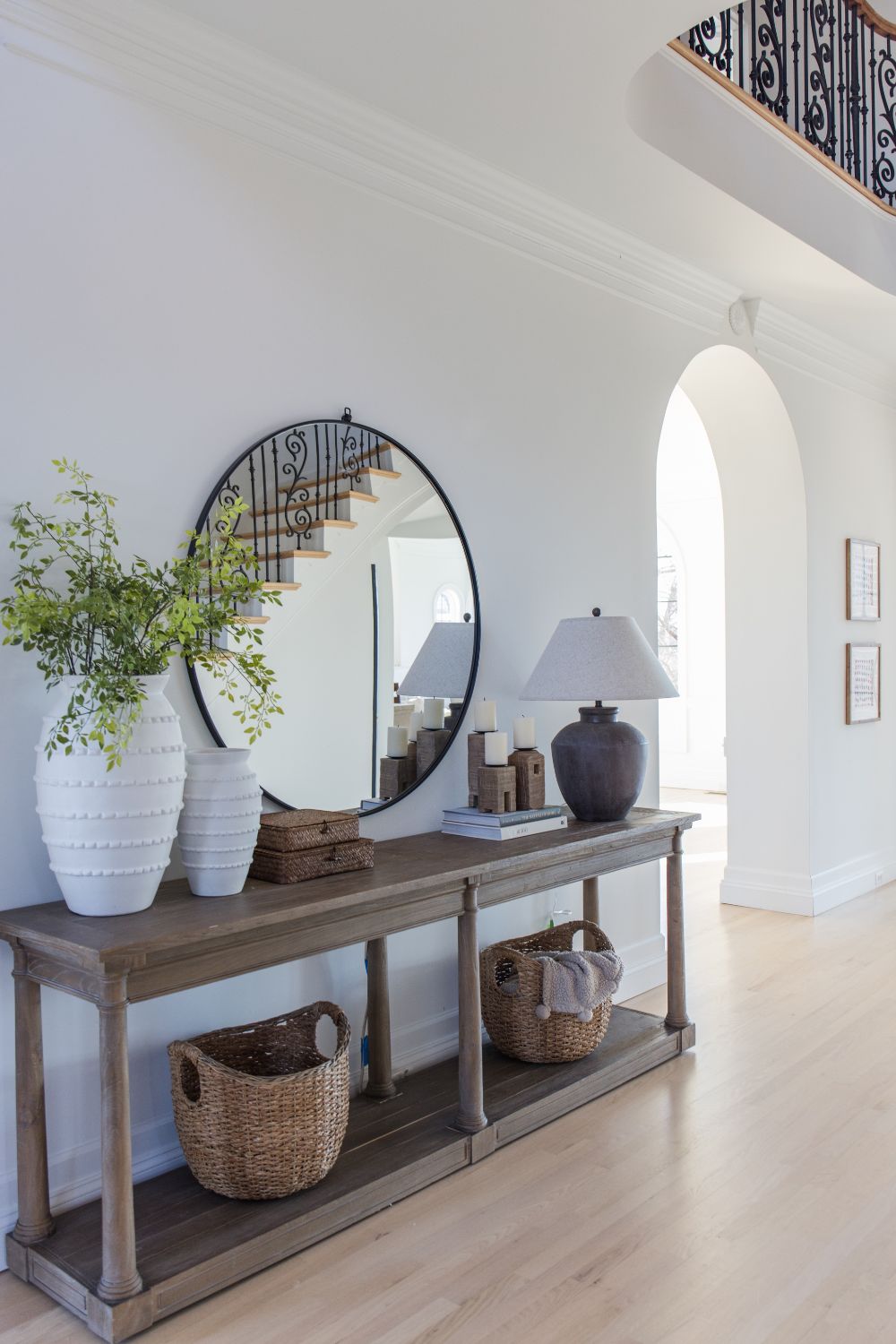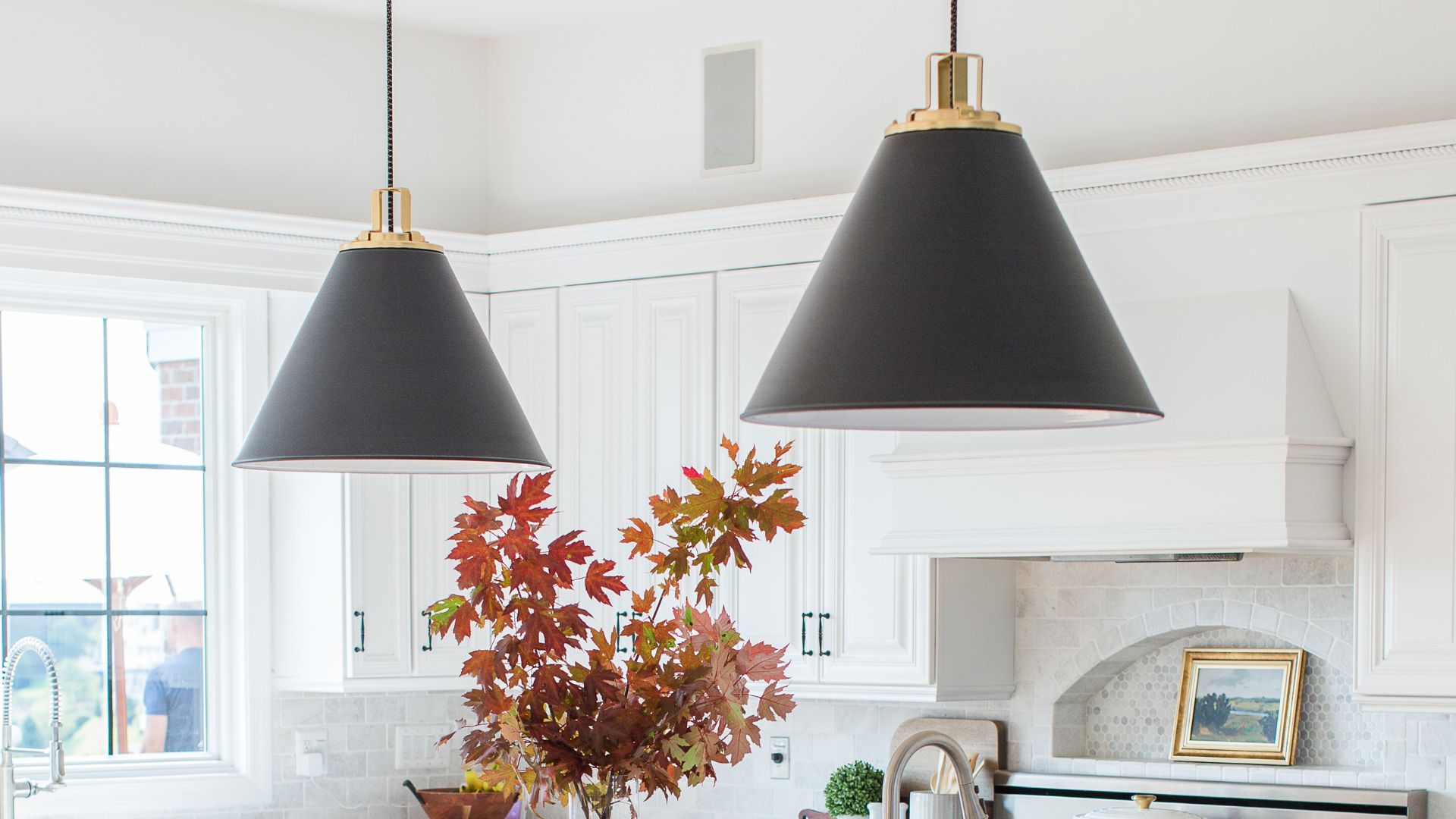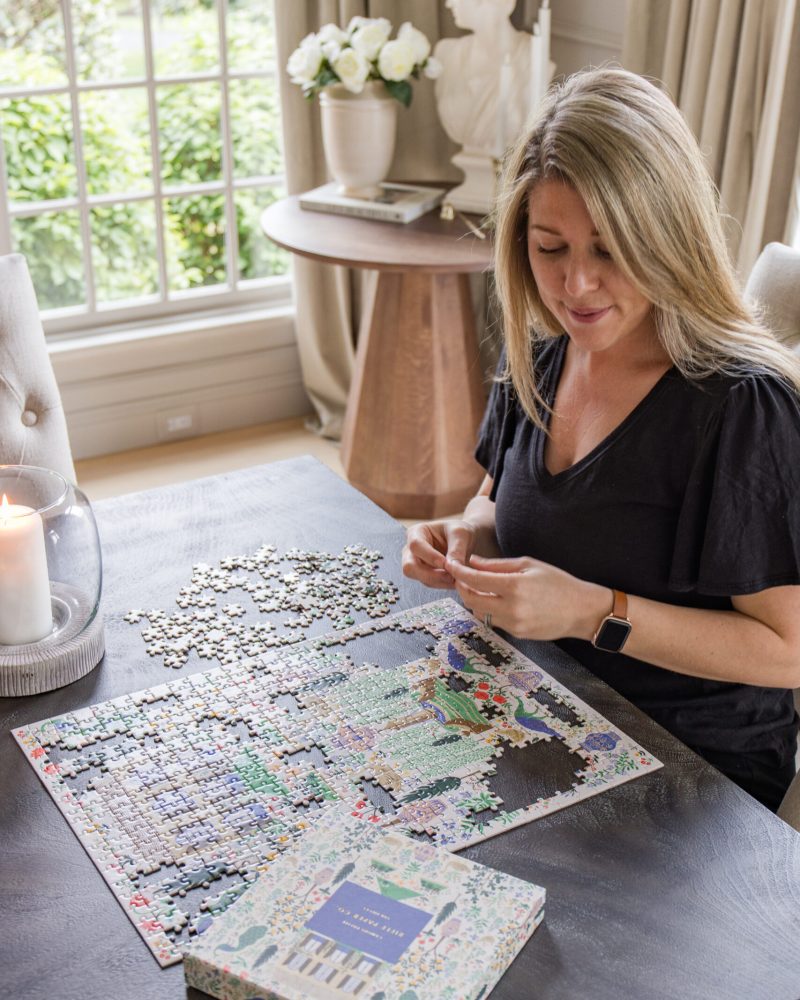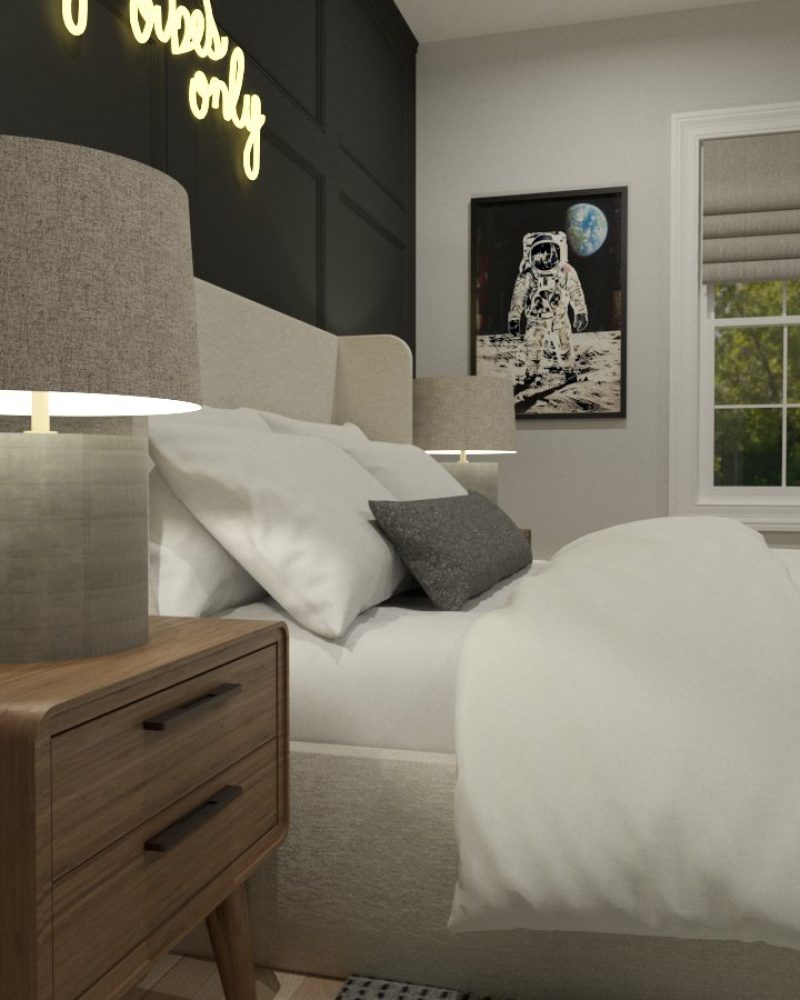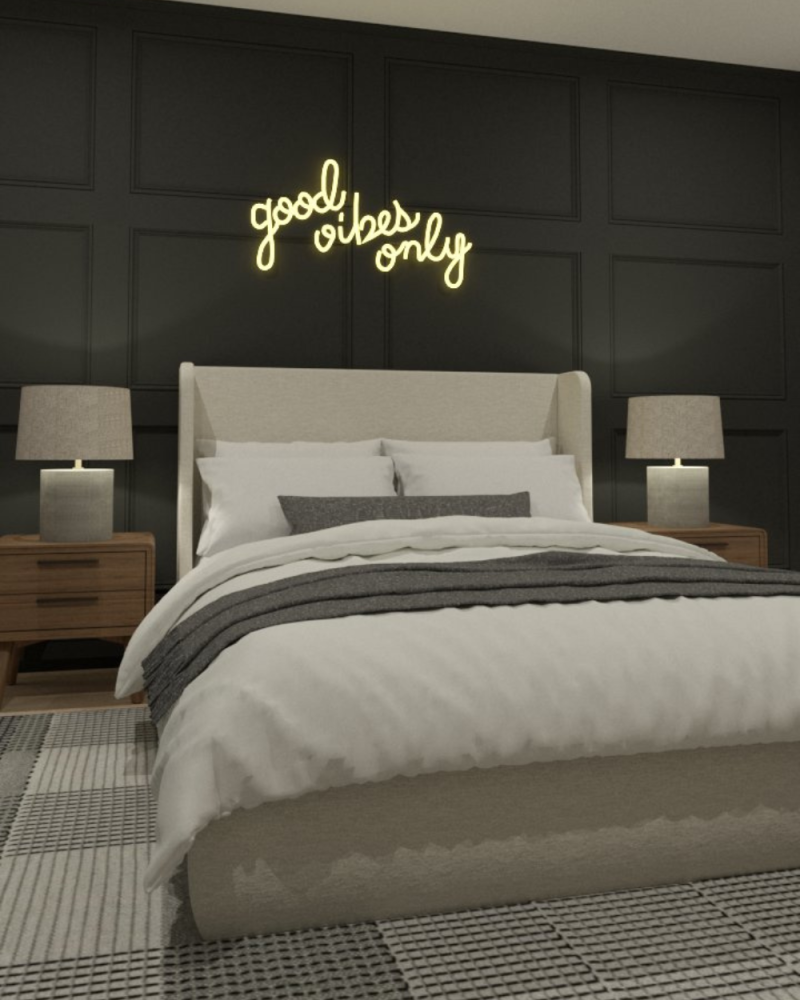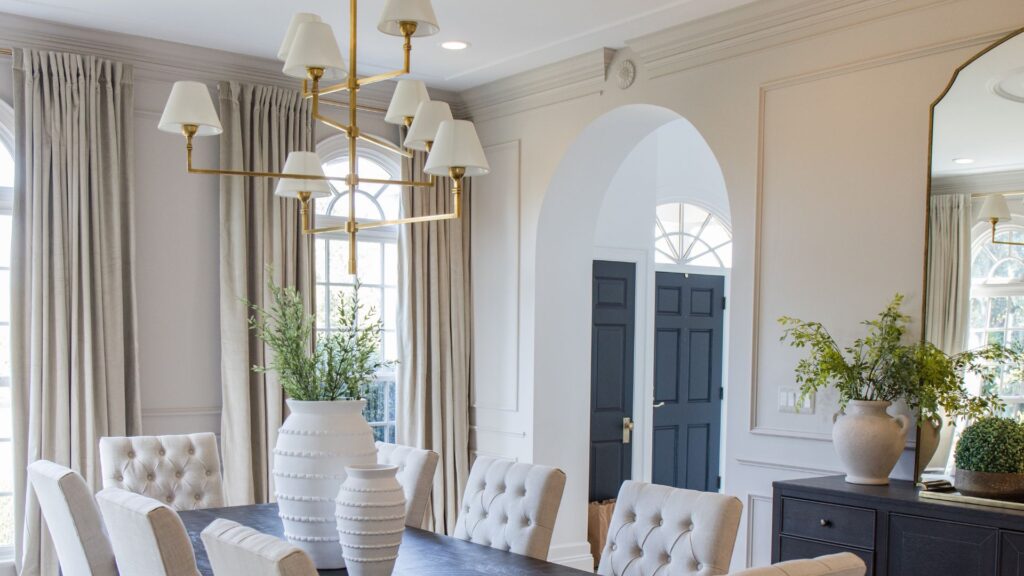
The dining room chandelier is more than just a source of light; it’s a statement piece, a focal point that sets the tone for your entire dining experience. The right chandelier can transform an ordinary meal into an elegant and atmospheric affair, but getting the right height is crucial for achieving the desired effect.
Ultimately the ideal height at which you hang any light fixture in a home is personal preference, however, let’s delve into some general guidelines you can follow when it comes to the art of hanging a new chandelier at the perfect height to create a harmonious balance between function and aesthetics.
Affiliate links may be used throughout this blog post – read our policy here.
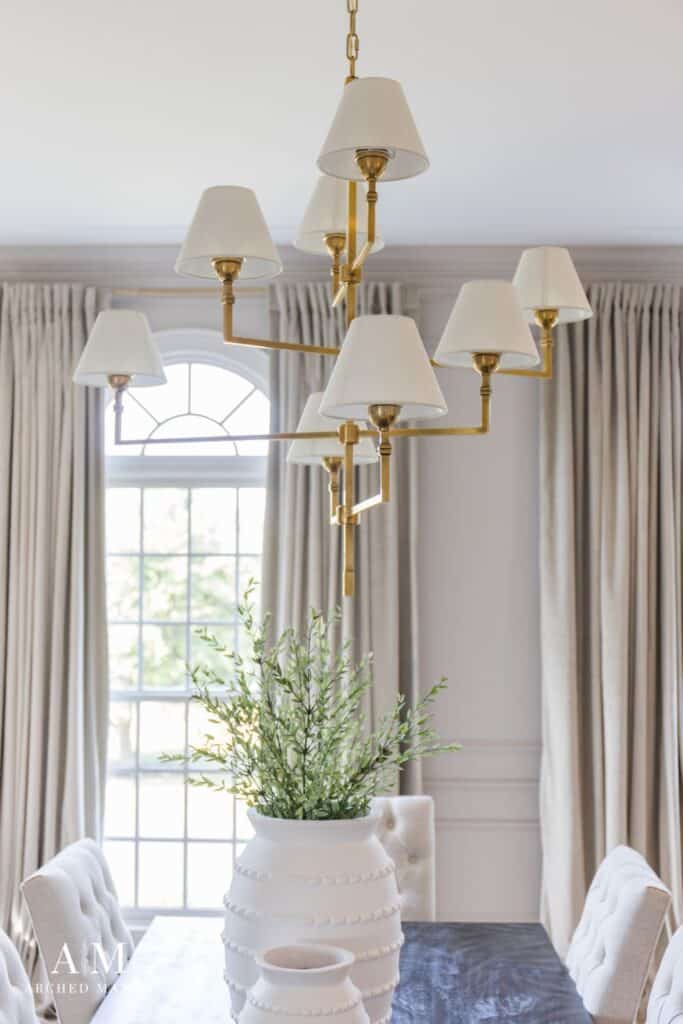
Consider the Room's Proportions
The first step in determining how low a dining room chandelier should hang is to consider the proportions of the room itself specifically the height of the ceiling. A good rule of thumb is that the bottom of the light fixture or chandelier should be positioned between 30 to 36 inches above the dining room table. However, the proper height can vary depending on the height of your ceiling, the overall size, whether you have a large room or small room, and the chandelier’s dimensions.
For rooms with standard heights like eight-foot ceilings or nine-foot ceilings, a chandelier hanging around 30 to 32 inches above the table usually works well. If your dining room boasts higher ceilings, you may need to adjust the height slightly upwards. On the other hand, if you have a lower ceiling, opt for the lower end of the recommended range.
Factor in the Chandelier's Size
The size of the chandelier plays a significant role in how it should be hung. A small chandelier might get lost if you have high ceilings and it’s hung too high, while a large chandelier hung too low can overwhelm the space and block sight lines. To strike the right balance, consider both the diameter of the chandelier as well as the height of the fixture.
Along with the size of the actual light fixture, the size of a dining room table can play a crucial role in determining the appropriate chandelier dimensions. As a general guideline, the chandelier’s diameter should be roughly half of the width of your table. This proportional relationship ensures that the chandelier creates an appealing balance, complementing the table surface and overall size without overwhelming the dining space.
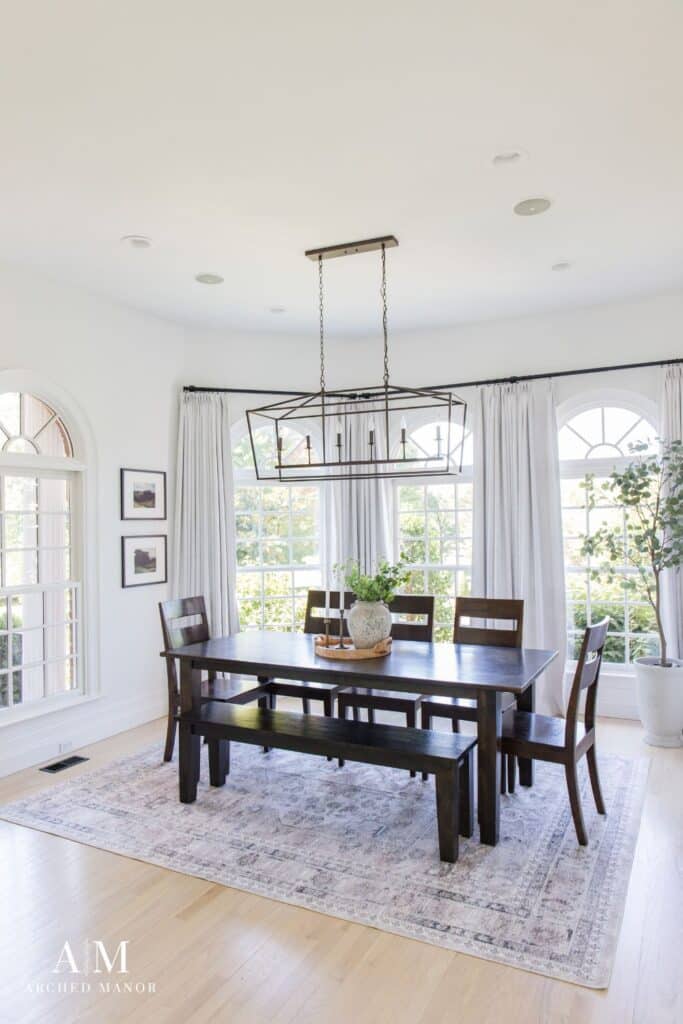
Create Visual Harmony
A well-placed chandelier should create a visual harmony between the top of the table, the chandelier itself, and the surrounding space. When seated at the table, you should have clear sight lines and be able to see your dining companions across the table without being blinded by the light source above.
To ensure this, stand back and assess the arrangement from various angles before finalizing the height. This is also a good time to make sure it is not blocking anything special in the space like artwork or other furniture. If possible, have someone hold the chandelier at the desired height while you assess its placement from both a seated position and from the perimeter of the space to help you make a decision.
Account for Activities and Decor
Consider how the dining room will be used when determining the chandelier’s height. If your dining room serves multiple purposes, such as a workspace during the day, a slightly higher chandelier might be more functional. Additionally, if your dining table often hosts elaborate centerpieces, you’ll want to leave enough clearance to showcase these decorations. Also, if your space is used for multiple uses, it may be a good idea to consider installing a dimmer switch to provide as much light as needed for each activity.
Tips on Hanging a Chandelier
Embarking on the installation of a dining room chandelier can be a gratifying DIY endeavor, provided you approach it with care and precision. Here are some tips for installing one at the right height:
- Preparation: Begin by turning off the power to the current fixture and carefully removing it.
- Chandelier Selection: Choose a chandelier that matches your ceiling’s structural support in terms of size and weight for stability and also matches your style (see next section).
- Safety First: Refer to the manufacturer’s instructions and prioritize safety measures when working with electrical components. If unsure, hire a professional electrician.
- Ceiling Medallion: Enhance support and aesthetics by installing a ceiling medallion before mounting the chandelier.
- Leveling: Ensure perfect balance by using a level tool to hang the chandelier evenly and at the proper height.
- LED Bulbs: Opt for energy-efficient LED bulbs, especially if the chandelier accommodates multiple bulbs.
- Professional Help: If electrical work feels overwhelming, consider consulting a professional for assistance.
- Final Check: Once securely installed, restore power and thoroughly inspect for any necessary adjustments to the chandelier’s position or lighting.
By adhering to these steps, you can confidently and effectively install a stunning dining room chandelier that adds both elegance and functionality to your space.


Shop Our Dining Room

Different Chandelier Styles to Consider
Chandeliers come in an array of styles, each designed to evoke a distinct ambiance and enhance various interior aesthetics. So when you are in the marketing for a new light fixture, what is the perfect chandelier for you?
For those drawn to a formal dining room and timeless elegance, the crystal chandelier takes center stage, casting dazzling light and creating a luxurious atmosphere. Another classic style would be chandeliers that adorn beautiful lamp shades. Modern enthusiasts might gravitate toward sleek and minimalist designs, often featuring clean lines and innovative materials like metal and glass. Rustic or farmhouse-inspired chandeliers exude a cozy charm, often crafted from wood and adorned with wrought iron details. Lantern chandeliers draw inspiration from vintage street lanterns, offering a blend of nostalgia and sophistication. Art Deco chandeliers boast geometric patterns and bold, intricate designs, perfect for those seeking a touch of vintage glamour. Meanwhile, industrial chandeliers embrace the raw beauty of exposed metal and utilitarian shapes, lending an edgy, urban feel. Whichever style resonates with your interior vision, the right chandelier can elevate your space into a work of art that brilliantly illuminates your personal taste.
Quick Tips for Other Lighting Fixtures
So we have discussed some general guidelines around the proper height to hang your dining room chandelier, but what are some good rules of thumb when it comes to hanging other fixtures in your home?
Pendant Lights – To determine the height of the pendants, the bottom of the pendant should be about 30-36 inches above the kitchen island countertop. This ensures ample illumination for tasks while maintaining a comfortable line of sight and an aesthetically pleasing balance. However this rule may change depending on the shape/style of your pendant lighting or ceiling height.
Living Room Fixture – When it comes to hanging a light fixture in a living room, the general rule of thumb is to aim for a height that allows at least 7 feet of clearance from the floor to the bottom of the chandelier. This ensures that the fixture provides adequate illumination while also avoiding any head clearance issues for the occupants in the room.
Bedroom Light or Fan – When hanging a bedroom light fixture or ceiling fan, consider a height that aligns with the room’s dimensions. For standard 8-foot ceilings, a distance of 6.5 to 7.5 feet from the floor to the bottom of the fixture is suitable. For higher ceilings, you can adjust the height slightly upwards to maintain a balanced visual proportion within the space.
In the world of interior design, balance is key, and the height at which a dining room chandelier hangs is no exception. By considering the dining space proportions, the chandelier’s size, creating visual harmony, and accounting for activities and décor, you can strike the perfect balance between function and aesthetics. Remember, there’s no one-size-fits-all answer; the ideal hanging height will vary based on your individual space and personal preference. So, take your time, experiment with different heights, and find the sweet spot that enhances the beauty and ambiance of your dining area. If in the end you are still feeling overwhelmed, the good news is that is what interior designers are for!
FAQs
Typically, aim for 30 to 36 inches above the table's surface to provide ample illumination while maintaining an aesthetically pleasing balance. However, read above for things to consider!
Yes, but you may need a sloped ceiling adapter or a chandelier designed for sloped ceilings to ensure it hangs level.
If you have taller than standard 8ft or 9ft ceilings you may want to consider hanging your chandelier higher. Make sure to read above for other factors to consider!
No, chandeliers should always be securely attached to an electrical junction box for safety. Seek professional help if needed.
Measure the foyer's height and width in feet, and add those numbers together. The chandelier's diameter in inches should be approximately equal to this sum.
Chandeliers designed for damp or wet locations can be used in bathrooms, but they must meet specific safety and building code requirements to ensure suitability in such areas. Always consult a professional for bathroom installations.

About The Authors
John and Megan are the founders of Arched Manor, which is a passion-project turned business featuring home design, renovations, DIY tutorials, décor, e-Design, and 3-D rendering services. This married couple lives in Leesburg, Virginia, and is currently renovating The Arched Manor, a brick colonial house built in 2000.





